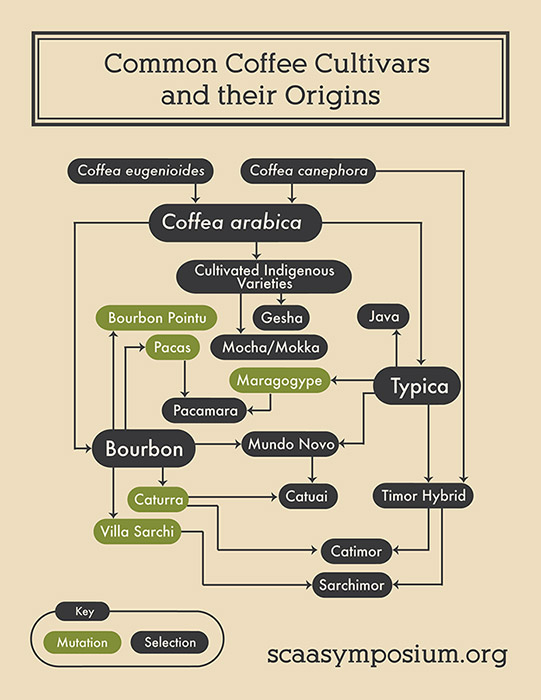A Botanists' Guide to Specialty Coffee
Taxonomy
Family: Rubiacea
This family is known as the "Coffee" or "Madder" family and has 450 genera and around 6,500 species worldwide. These plants typically have simple leaves (undivided) that are opposite (two leaves at the node, usually near a lateral bud or shoot) or sometimes whorled (more than 2 around a node). Flowers usually have both male and female sex organs.
Genus: Coffea. Overall, the genus has about 100 species, only a few of which are commercially relevant.
Species: arabica makes up approximately 70% of the world's coffee production. Other species not so common in specialty include canephora (var."Robusta") and liberica. Of all of the Coffea species, only arabica is self-fertile, and therefore can be self-pollinated. The arabica species also typically have lower caffeine contents than canephora.
Figure 2 from Eira et al., 2006 Coffea seeds of different sizes. A- C. racemosa; B- C. canephora; C- C. arabica; D- C. liberica. The bar corresponds to 1cm.
Image used with permission from Coffee Seed Physiology, Braz J. Plant Physiol., 18(1):149-163, 2006
What is a variety? Cultivar? Hybrid?
In the coffee industry we tend to use the below terms interchangeably despite the fact that they do have specific botanical meanings. For more in-depth geekery, visit iapt-taxon.org, kew.org, and rhs.org.uk
Variety: This rank of taxa delineates differences between plants that are smaller than in subspecies but larger than forms. A variety retains most of the characteristics of the species, but differs in some way.
Cultivar: Any variety produced by horticultural or agricultural techniques and not normally found in natural populations; a cultivated variety. Most of the varieties we know in specialty coffee are really cultivars. Bourbon and Typica are some of the most widely known cultivars.
Click to enlarge.
This diagram represents the relationships between the most common coffee species, varieties, and cultivars. Lines and arrows linking plant groups indicate parentage. Line lengths do not represent relative relatedness or genetic distances. Arrows toward mutations represent that those cultivars that resulted from a spontaneous genetic change. Arrows toward selections indicate a selection made by humans that resulted in a differentiated variety or cultivar, or in the case of C. arabica, a natural hybrid cross which occurred in nature.
Hybrid: Hybrids are created by crosses between two different species or two different forms of the same species. Hybrids may occur through naturally or selective breeding. For example, mundo novo is a hybrid of typica and bourbon. They are indicated in botanical terminology by a multiplication sign between the two parents.
Coffee - Tree or Shrub? Fruit or Seed?
Coffea can be as small as a small shrub or as tall as a medium-sized tree, depending on the species and cultivar. They can stand up to 8 meters tall. Pruning can also dwarf naturally taller varietals. Most specialty coffee is on the smaller side (canephora is one of the largest species).
Other growth information: Coffea has opposite leaves, which means the leaves branch out in matching pairs from the stem.
The fruit is a 2-seeded "drupe" fruit, commonly called the cherry. Technically a stone fruit, the seeds are the coffee "beans". However, if you squeeze open the coffee fruit you will find that there is hardly any "fruit" at all, but most of the drupe is filled by the two slippery seeds.
Coffee Physiology: The Nutrient Cycle
Click to enlarge.
A healthy "happy" coffee plant is one that is able to produce the greatest number of quality seeds. There are common biological necessities universal to all plants that make this possible. Plants interact with the soil, weather, microorganisms, temperature, humidity and a myriad of other influences to obtain the nutrients they need and continue growth and reproduction. To function, plants "inhale" and "exhale" the building blocks of life. The "inhale" is called photosynthesis, and the "exhale" is called respiration; both depend on water, energy from the sun, and nutrients. Plants take in nutrients and water from the soil though their roots. In addition, plant evapotranspiration causes plants to lose water and can impact the water balance of an entire plantation or ecosystem. This diagram outlines the key physiological nutrient cycles of Coffea arabica and many other plants, including photosynthesis and respiration, water uptake and transpiration, and nutrient uptake and allocation.
Read more by Emma Bladyka in Basic Plant Biology: Keeping the Coffee Plant "Happy"? on SCA News.
What is coffee skin? Parchment? Pulp?
The coffee drupe's skin is called the exocarp or the epicarp, and underneath it is a pulp layer called mesocarp. Finally, under those is the slimy parenchyma, which is the goo that is eaten away during the fermentation process in processing.
The beans themselves are covered in the endocarp, known in the industry as parchment. Inside the parchment are the two coffee seeds, each covered by another membrane known as silver skin.
Figure 1.1 Coffee cherry (fruit). From Wintgens, J. N.: Coffee: Growing, Processing, Sustainable Production. Page 4. 2009. Copyright Wiley-VCH Verlag GmbH & Co. KGaA. Reproduced with permission.
Interested in learning more about coffee botany and biology?
Check out the SCA Coffee Biology Glossary Handbook on the SCA Store!







